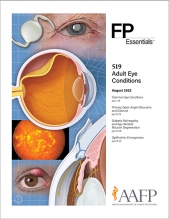
This clinical content conforms to AAFP criteria for CME.
In primary care practices and emergency departments, approximately 2% to 3% of visits are related to eye conditions. The most common diagnoses are corneal abrasion, corneal foreign body, conjunctivitis, external hordeolum (stye), and subconjunctival hemorrhage. This section addresses hordeolum, chalazion, conjunctivitis, corneal abrasion, and corneal foreign body. A thorough history and physical examination are crucial for patients with these conditions, and frequently are sufficient for diagnosis. Conservative therapies are first-line treatments for hordeolum and chalazion, including application of warm compresses, eyelid scrubs, and eyelid massage. Conjunctivitis is the most common etiology of red eye and has infectious and noninfectious causes. Bacterial conjunctivitis typically resolves in 1 to 2 weeks, but can be managed with topical antibiotic solutions or ointments. Viral conjunctivitis management involves frequent handwashing and use of cool compresses and artificial tears. Corneal abrasion is the most common eye injury seen in emergency departments, and corneal foreign body is the second most common. Topical antibiotics and cycloplegics are mainstay therapies for corneal abrasion, with consideration of topical nonsteroidal anti-inflammatory drugs for pain management. Follow-up visits are recommended for select patients. Management of corneal foreign body requires prompt removal of the object, pain management, consideration of prophylactic antibiotics, and follow-up when appropriate.
Subscribe
From $350- Immediate, unlimited access to FP Essentials content
- 60 CME credits/year
- AAFP app access
- Print delivery available
Edition Access
$44- Immediate, unlimited access to this edition's content
- 5 CME credits
- AAFP app access
- Print delivery available
